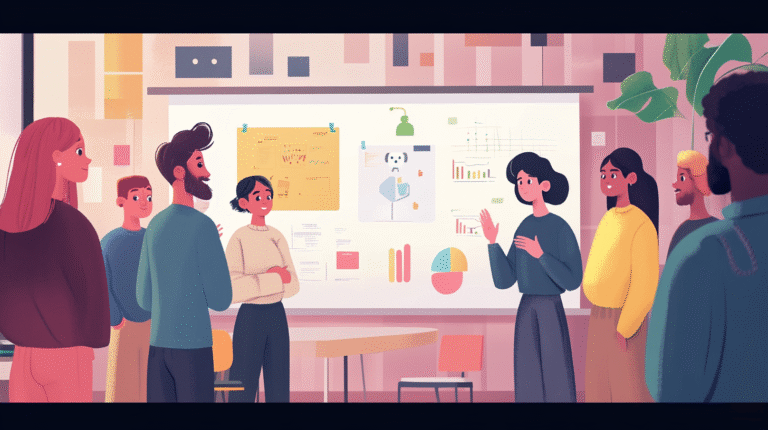9 Ways AI and Humans Can Collaborate
Generative AI is rapidly reshaping the business landscape, so understanding effective human-AI collaboration is more crucial than ever. However, many around me still face challenges in understanding how to collaborate effectively with these systems, if at all.
In recent posts, we’ve explored various aspects of AI integration in professional settings. Today, let’s dig deeper into how AI and humans can work together effectively.
1. Generate & Curate: From Information Overload to Focused Insight
Drowning in a sea of information, struggling to find what’s relevant? We’ve all been there, right? Well, this is where AI shines. It can rapidly generate a wide array of content, ideas, or data points.
Our job? To curate. We use our judgment, experience, and understanding of context to select and refine the most valuable outputs.
Imagine you’re researching for a new project. Instead of spending hours scouring the internet, let AI generate a comprehensive list of resources and ideas. Then, apply your expertise to identify the gems that truly matter for your specific needs.
Key Takeaway: Let AI handle the heavy lifting of information gathering, while you focus on selecting and refining what’s truly valuable.
2. Analyze & Interpret: Turning Data into Actionable Insights
AI excels at processing vast amounts of data at incredible speeds, identifying patterns and correlations that might take us weeks to spot. But data without context is just numbers.
This is where we come in. Our role is to interpret these findings, contextualizing them within broader business or societal trends and deriving actionable insights.
For instance, AI might analyze market trends and customer behavior data. It’s up to us to interpret what these trends mean for our business strategy and how we can leverage them for growth.
Key Takeaway: Use AI for rapid data analysis, then apply your expertise to interpret the results and create actionable strategies.
3. Suggest & Refine: From AI Recommendations to Tailored Solutions
Based on its analysis, AI can suggest potential solutions or strategies. But these suggestions often need refinement. We bring in our nuanced understanding of current circumstances, ethical considerations, and long-term goals to shape these AI-generated ideas into practical, effective solutions.
Think of AI as a brainstorming partner on steroids. It might suggest a marketing strategy based on data analysis. Our job is to refine this strategy, considering factors like brand voice, company values, and potential long-term impacts that AI might not fully grasp.
Key Takeaway: View AI as a powerful brainstorming tool, but rely on your judgment to refine and tailor its suggestions to your specific context.
4. Test & Learn: Rapid Experimentation, Human-Led Learning
One of AI’s superpowers is its ability to run multiple tests or simulations rapidly. It can A/B test hundreds of variants in the time it would take us to set up a single experiment. Our role? To interpret these results, extract meaningful lessons, and apply this learning to future strategies.
This collaboration is particularly powerful in areas like product development or marketing. AI can test multiple product features or ad variations quickly, while we focus on understanding why certain options performed better and how to apply these insights in our next iteration.
Key Takeaway: Leverage AI for rapid testing and experimentation, then focus your efforts on extracting meaningful insights from the results.
5. Implement & Oversee: Automation with a Human Touch
AI excels at executing repetitive tasks and automating processes at scale. But automation without oversight can lead to unexpected issues. Our role is to monitor these operations, make necessary adjustments, and ensure alignment with overall objectives and ethical standards.
For example, AI might automate your email marketing campaign execution, but you’ll need to oversee the process, ensuring the content aligns with your brand voice and that the automation doesn’t lead to any unintended consequences.
Key Takeaway: Use AI to automate repetitive tasks, but maintain human oversight to ensure quality, alignment with goals, and ethical considerations.
6. Evaluate & Assess: Measuring Success, Understanding Impact
AI can collect and process performance metrics and outcome data with ease. However, evaluating success isn’t just about numbers. It’s our job to interpret this information in the context of broader goals, assess the true success of our strategies, and make informed decisions about future directions.
When reviewing the performance of a project, AI can provide detailed metrics. We then need to assess whether these metrics truly reflect success in terms of our overall business objectives and stakeholder expectations.
Key Takeaway: Let AI handle data collection and initial analysis, but rely on your judgment to evaluate true success and make strategic decisions.
7. Adapt & Guide: Steering AI’s Learning for Optimal Outcomes
Many AI systems continuously update based on new data and feedback. Our crucial role here is to guide this learning process. We need to ensure it aligns with organizational values and objectives, steering it towards beneficial outcomes.
For instance, if you’re using AI in customer service, you’ll need to guide its learning to ensure it’s not just optimizing for speed, but also for customer satisfaction and problem resolution.
Key Takeaway: Actively guide AI’s learning process to ensure it aligns with your organization’s values and objectives.
8. Synthesize & Innovate: From AI-Assisted Connections to Human Creativity
AI has an impressive ability to merge diverse data points and ideas, identifying novel connections. This can serve as a launchpad for human creativity. We can use these AI-generated connections as a foundation for true innovation, creating original solutions and pushing boundaries in ways that AI alone cannot.
Imagine you’re developing a new product. AI might identify unexpected correlations between user behaviors. It’s then up to us to use this information creatively, potentially leading to innovative features that address user needs in entirely new ways.
Key Takeaway: Use AI-generated insights as a springboard for your own creative thinking and innovation.
9. Draft & Communicate: AI-Generated Content, Human-Refined Messaging
Finally, AI can generate initial content or communication drafts based on data and patterns. Our role is to refine this content, adding nuance and emotional intelligence, ensuring it resonates with the intended audience before final delivery.
This collaboration is particularly useful in content creation. AI can draft reports or presentations, but we need to refine the message, ensuring it aligns with our communication goals and connects with our audience on a human level.
Key Takeaway: Let AI handle initial content creation, then apply your communication skills to refine and personalize the message.
Ethical Considerations in AI-Human Collaboration
As we adopt these collaborative approaches, it’s crucial to also be aware of the ethical implications. AI systems, while powerful, can perpetuate biases present in their training data or make decisions that may have unintended consequences. As human collaborators, we have a responsibility to:
- Regularly audit AI outputs for bias and fairness
- Ensure transparency in AI-assisted decision-making processes
- Maintain accountability for outcomes, recognizing that AI is a tool, not a scapegoat
- Consider the long-term societal impacts of AI-human collaborative systems
This way, we make sure that our collaboration with AI not only enhances productivity but also contributes positively to our organizations and society at large.
Embracing the AI-Human Synergy
Collaborating with AI as described above, can and will significantly enhance your productivity and effectiveness. The key is to view AI not as a replacement, but as a powerful tool that augments our uniquely human capabilities.
By leveraging AI’s strengths in data processing, pattern recognition, and rapid task execution, we free up our cognitive resources for higher-level thinking, creativity, and strategic decision-making. This synergy allows us to work smarter, not harder, and to focus on the aspects of our work that truly require human insight and creativity.
Remember, the goal isn’t to compete with AI, but to collaborate with it.
Key Takeaway: Embrace AI as a collaborative tool that enhances your unique human capabilities, allowing you to focus on high-value tasks that require creativity and strategic thinking.
How are you collaborating with AI in your work? I’d love to hear your experiences and insights in the comments below!
Take Your AI Collaboration Skills to the Next Level
If you’re looking to dive deeper into practical AI applications and learn how to effectively integrate these collaboration methods into your workflow, I’m here to help. I offer personalized workshops and coaching sessions designed to help you master AI, from tailored strategies and prompt engineering to creating custom AI assistants and AI Agents.
I only have bandwidth to take on 1-2 clients per month, so if you’re interested in elevating your AI skills and boosting your productivity, don’t hesitate to reach out. Together, we can explore how to make AI your most powerful collaborator.






